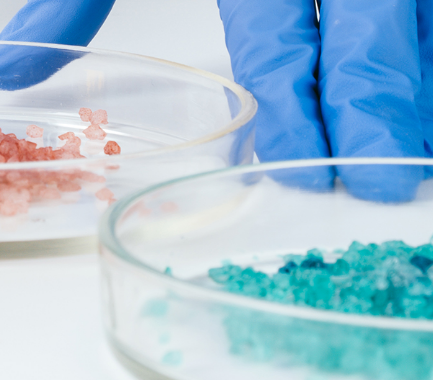Your contact
PENPET-Team - Hamburg

Tim Meister
Sales
Tel. +49 (0) 40 - 675 7 99 40
sales@penpet.de
Get in touch with us.
2-Ethylhexyl acrylate (2-EHA)
2-Ethylhexyl acrylate (2-EHA) is an organic substance that belongs to the group of acrylic acid esters and is one of the most important starting materials for the production of acrylate-based adhesives. The compound is prepared in a commercial process by the esterification of 2-ethylhexanol and acrylic acid in the presence of methanesulfonic acid or other strong acids and using polymerization inhibitors such as hydroquinone.
Alongside butyl acrylate, 2-ethylhexyl acrylate is one of the most important starting materials for the production of polymer acrylate adhesives. The compound is also used in the production of paints, printing inks, coatings and impregnations and is used in radiation curing processes as a reactive diluent for paints.
At PENPET you can order the required amount of 2-ethylhexyl acrylate (2-EHA) in an uncomplicated and sustainable way. We look forward to receiving your inquiry for an individual offer. Delivered as a liquid in ISO tank containers. The product is mixed with the stabilizer MEHQ.
CAS no. 103-11-7
EINECS no. 203-080-7
Molecular formula: C11H20O2
Synonyms: 2-ethylhexyl acrylate, 2-ethylhexyl 2-propenoate, octyl acrylate, ethylhexyl acrylate, 2-EHA
Areas of application: Base material for the production of polymer acrylic adhesives, printing inks, paints, coatings and impregnations, use as a reactive diluent for radiation curing of paints
More Information
As an ester of acrylic acid, 2-ethylhexyl acrylate (2-EHA) consists of two components that have been linked together in the course of an esterification. The alcoholic part of its molecules is a residue of the branched alcohol ethylhexanol, whose functional hydroxy group has been replaced by an ester group during the manufacturing process, which connects it to the acrylic acid residue. Due to the resulting double bond between two carbon atoms of the acrylic group and the central ester group, 2-ethylhexyl acrylate has two reactive sites. The compound is therefore suitable as a monomer for polymerization processes.
The substance is available in two mirror-symmetrical forms that differ in the way their components are arranged in space. We supply 2-ethylhexyl acrylate in racemic mixture containing both forms in equal proportions.
2-Ethylhexyl acrylate is a colorless to slightly yellowish liquid that is very difficult to dissolve in water. Due to its lower density, it floats on contact with water. 2-Ethylhexyl acrylate only solidifies at very low temperatures from -90 °C and boils at 214 °C. The compound is very difficult to volatilize. It has a pleasant, sweet smell.
2-Ethylhexyl acrylate (2-EHA) is chemically unstable and tends to spontaneously polymerize and decompose without stabilizing additives. This process can also be triggered or enhanced by heating, exposure to light, contamination, and exposure to peroxides. The substance also reacts violently with strong oxidizing agents, generating a lot of heat.
2-Ethylhexyl acrylate is a combustible substance, but is considered to be difficult to ignite under normal conditions. However, the tendency to ignite increases sharply with increasing temperature. The vapors of the compound can also form highly flammable and explosive mixtures with the ambient air. They are denser than air and can collect on the ground and spread unnoticed. As a result, hazardous remote ignition of the substance is possible. When storing and processing 2-ethylhexyl acrylate, it is therefore important to ensure that there is a sufficiently large distance to sources of ignition such as electrical devices, electrostatic discharges, sparks from grinding and welding work, as well as hot surfaces and open flames. Combustion of the substance leads to the formation of toxic and irritating gases. Among other things, dangerous amounts of carbon monoxide can be released.
The compound has a skin-irritating and skin-damaging effect. When handling 2-ethylhexyl acrylate (2-EHA), appropriate occupational health and safety measures must be observed. Direct contact may cause skin redness, irritation and chemical burns. Sustained sensitization and allergic reactions are possible. In the eye, 2-ethylhexyl acrylate causes redness and temporary swelling of the conjunctiva and cornea, which can cause temporary impairment of vision. Wetted areas of the body should be cleaned thoroughly with water. Cleaning with polyethylene glycol 400 is also recommended for the skin. Medical treatment may be required depending on the level of exposure.
Inhalation of vapors and aerosols of the compound causes irritation of the upper respiratory tract and, at higher concentrations, also of the lungs. With high exposure, pulmonary edema is possible. Ingestion of 2-ethylhexyl acrylate can cause irritation of the mucous membranes and the stomach as well as gastrointestinal symptoms such as stomach pain, nausea, vomiting and diarrhea. In addition to rinsing the mouth thoroughly and drinking sufficient quantities of water, arrange for a medical examination to be carried out.
2-Ethylhexyl acrylate was rated as slightly hazardous to water. It is important to prevent the compound from penetrating waterways or the ground and from escaping into the sewage system. The competent authorities must be notified of the release of larger quantities into the environment. The substance is not subject to any special transport regulations.
